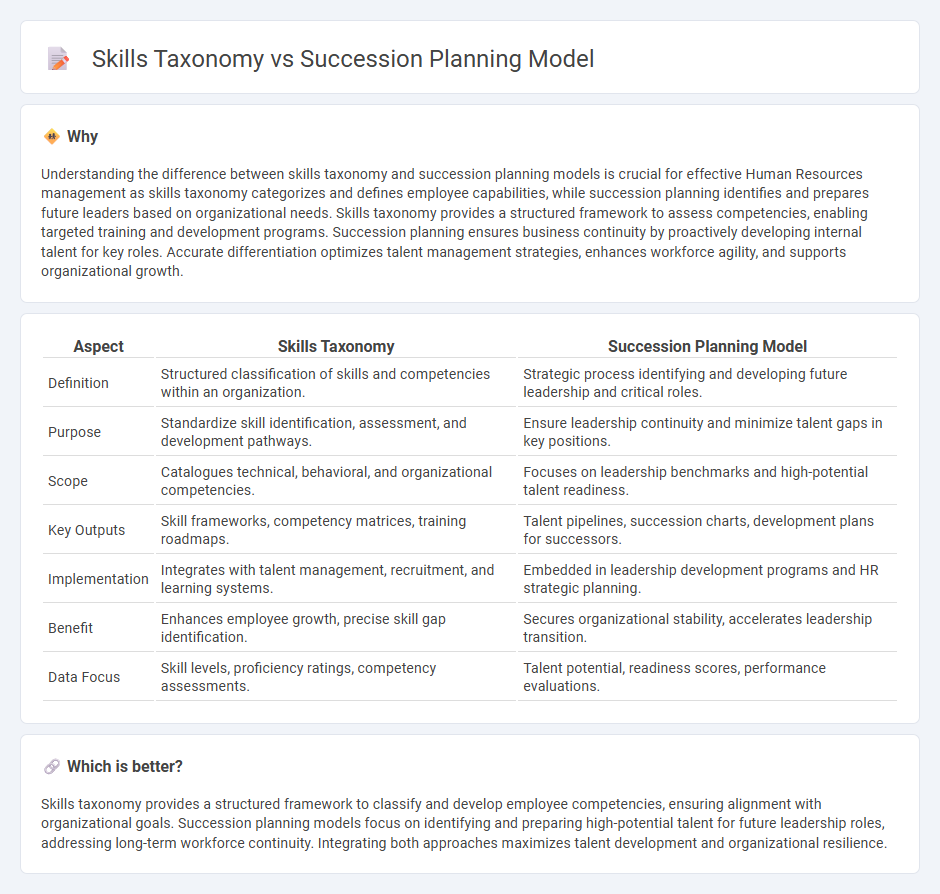
Skills taxonomy organizes employee capabilities into a structured framework to streamline talent management, while succession planning models focus on identifying and developing future leaders for critical roles within an organization. Integrating skills taxonomy with succession planning enhances strategic workforce development and ensures continuity in leadership. Explore deeper insights into how aligning these frameworks drives organizational growth and resilience.
Why it is important
Understanding the difference between skills taxonomy and succession planning models is crucial for effective Human Resources management as skills taxonomy categorizes and defines employee capabilities, while succession planning identifies and prepares future leaders based on organizational needs. Skills taxonomy provides a structured framework to assess competencies, enabling targeted training and development programs. Succession planning ensures business continuity by proactively developing internal talent for key roles. Accurate differentiation optimizes talent management strategies, enhances workforce agility, and supports organizational growth.
Comparison Table
| Aspect | Skills Taxonomy | Succession Planning Model |
|---|---|---|
| Definition | Structured classification of skills and competencies within an organization. | Strategic process identifying and developing future leadership and critical roles. |
| Purpose | Standardize skill identification, assessment, and development pathways. | Ensure leadership continuity and minimize talent gaps in key positions. |
| Scope | Catalogues technical, behavioral, and organizational competencies. | Focuses on leadership benchmarks and high-potential talent readiness. |
| Key Outputs | Skill frameworks, competency matrices, training roadmaps. | Talent pipelines, succession charts, development plans for successors. |
| Implementation | Integrates with talent management, recruitment, and learning systems. | Embedded in leadership development programs and HR strategic planning. |
| Benefit | Enhances employee growth, precise skill gap identification. | Secures organizational stability, accelerates leadership transition. |
| Data Focus | Skill levels, proficiency ratings, competency assessments. | Talent potential, readiness scores, performance evaluations. |
Which is better?
Skills taxonomy provides a structured framework to classify and develop employee competencies, ensuring alignment with organizational goals. Succession planning models focus on identifying and preparing high-potential talent for future leadership roles, addressing long-term workforce continuity. Integrating both approaches maximizes talent development and organizational resilience.
Connection
Skills taxonomy organizes and categorizes employee competencies, providing a clear framework to identify critical skills for various roles. This structured inventory informs succession planning models by highlighting skill gaps and potential candidates ready for advancement. Integrating skills taxonomy with succession planning ensures strategic talent development and seamless leadership transitions within an organization.
Key Terms
Succession Planning Model:
A Succession Planning Model strategically identifies and develops internal talent to ensure leadership continuity and mitigate risks associated with key position vacancies. This model incorporates organizational hierarchy data, performance metrics, and potential assessments to create robust talent pipelines aligned with long-term business goals. Explore how a well-structured Succession Planning Model can drive seamless leadership transitions and sustain competitive advantage.
Leadership Pipeline
Succession planning models prioritize identifying and developing future leaders by mapping key roles and creating tailored development paths, while skills taxonomies offer a structured classification of leadership competencies essential for these roles. The Leadership Pipeline framework integrates both approaches by defining leadership transitions and the necessary skills, behaviors, and values at each stage of leadership growth. Explore how combining succession planning models with skills taxonomies enhances effective leadership development strategies.
Talent Pool
Succession planning models identify and develop internal candidates for critical roles by assessing their potential and readiness, while skills taxonomy categorizes and organizes the specific competencies required for various positions within the talent pool. Effective talent pool management integrates these frameworks to ensure alignment between individual skill sets and organizational leadership needs. Explore how combining succession planning with skills taxonomy can optimize your talent pipeline and drive strategic workforce development.
Source and External Links
Succession Planning: All You Need To Know [2025 Edition] - A succession planning model integrates talent and leadership development, involving spotting, identifying, and preparing high-potential employees over time through programs like mentoring, career planning, and job rotation to ensure leadership continuity in critical roles.
Succession planning: How it works & best practices - The model involves forecasting future organizational needs, identifying vulnerable leadership positions needing successors, and defining timelines, KPIs, and budgets to prepare internal candidates for leadership transitions effectively.
Succession Planning: 7-Step Guide & Template - Practical succession planning models include tools like the 9-box method to assess high-potential employees and skills analysis to identify and develop potential successors for critical roles, ensuring smooth leadership transitions.
 dowidth.com
dowidth.com